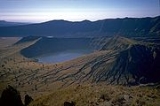
Marrah Mountains
Encyclopedia
The Marrah Mountains or Marra Mountains (Jebel Marra, bad mountains) is a range of volcanic peaks created by a massif
that rises up to 3,000 m. It is located in the center of the Darfur
region of Sudan
, specifically within Dar Zagahawa and neighboring areas. The highest point is Deriba Caldera. The upper reaches of the massif is a small area of temperate climate with high rainfall and permanent springs of water.
The last eruption occurred around 2000 BC. The centre of activity was Deriba Caldera, and involved caldera
collapse following the eruption of pumice
and pyroclastic flow
s which travelled over 30 kilometres (19 mi) from the volcano.
Massif
In geology, a massif is a section of a planet's crust that is demarcated by faults or flexures. In the movement of the crust, a massif tends to retain its internal structure while being displaced as a whole...
that rises up to 3,000 m. It is located in the center of the Darfur
Darfur
Darfur is a region in western Sudan. An independent sultanate for several hundred years, it was incorporated into Sudan by Anglo-Egyptian forces in 1916. The region is divided into three federal states: West Darfur, South Darfur, and North Darfur...
region of Sudan
Sudan
Sudan , officially the Republic of the Sudan , is a country in North Africa, sometimes considered part of the Middle East politically. It is bordered by Egypt to the north, the Red Sea to the northeast, Eritrea and Ethiopia to the east, South Sudan to the south, the Central African Republic to the...
, specifically within Dar Zagahawa and neighboring areas. The highest point is Deriba Caldera. The upper reaches of the massif is a small area of temperate climate with high rainfall and permanent springs of water.
The last eruption occurred around 2000 BC. The centre of activity was Deriba Caldera, and involved caldera
Caldera
A caldera is a cauldron-like volcanic feature usually formed by the collapse of land following a volcanic eruption, such as the one at Yellowstone National Park in the US. They are sometimes confused with volcanic craters...
collapse following the eruption of pumice
Pumice
Pumice is a textural term for a volcanic rock that is a solidified frothy lava typically created when super-heated, highly pressurized rock is violently ejected from a volcano. It can be formed when lava and water are mixed. This unusual formation is due to the simultaneous actions of rapid...
and pyroclastic flow
Pyroclastic flow
A pyroclastic flow is a fast-moving current of superheated gas and rock , which reaches speeds moving away from a volcano of up to 700 km/h . The flows normally hug the ground and travel downhill, or spread laterally under gravity...
s which travelled over 30 kilometres (19 mi) from the volcano.

